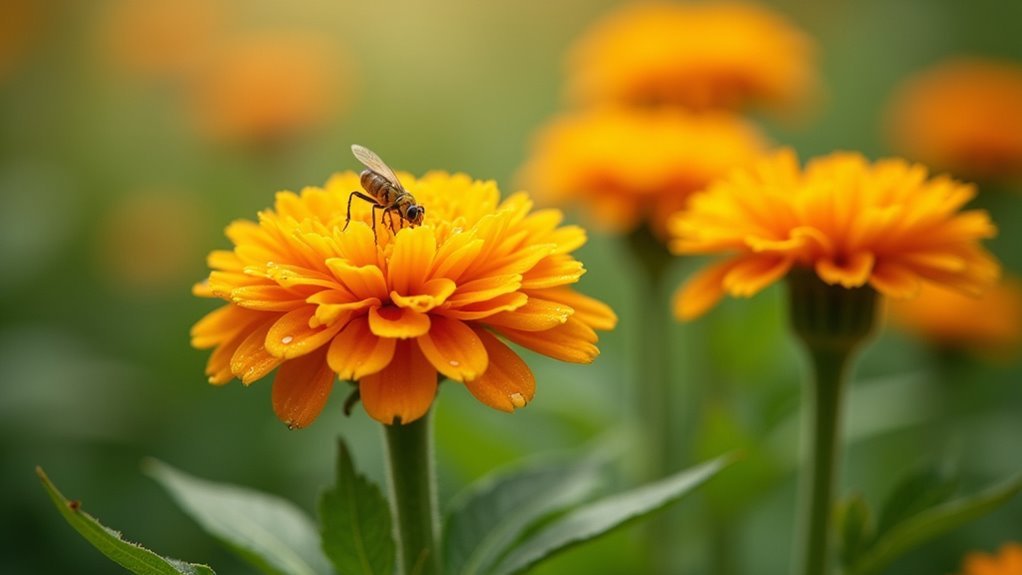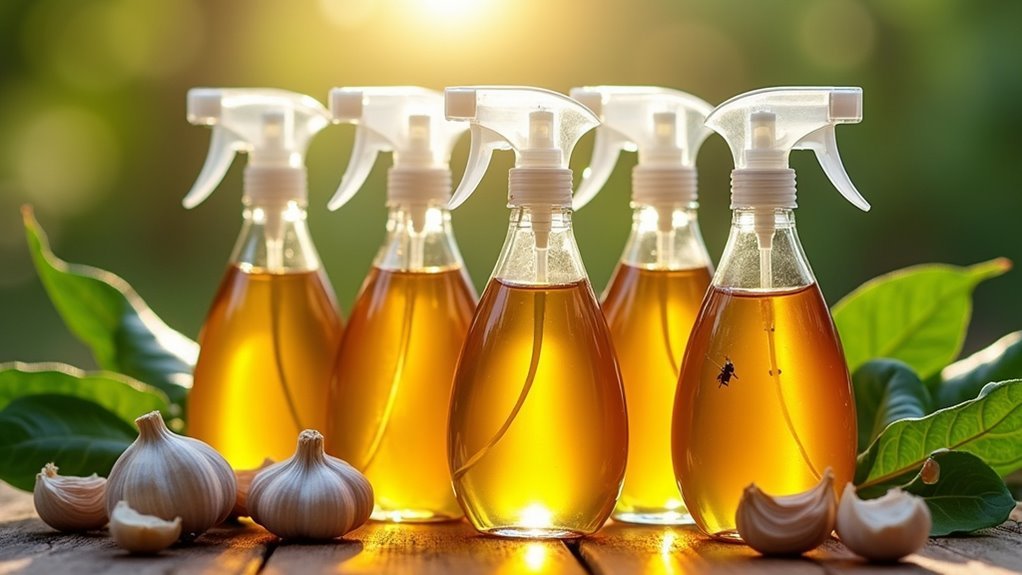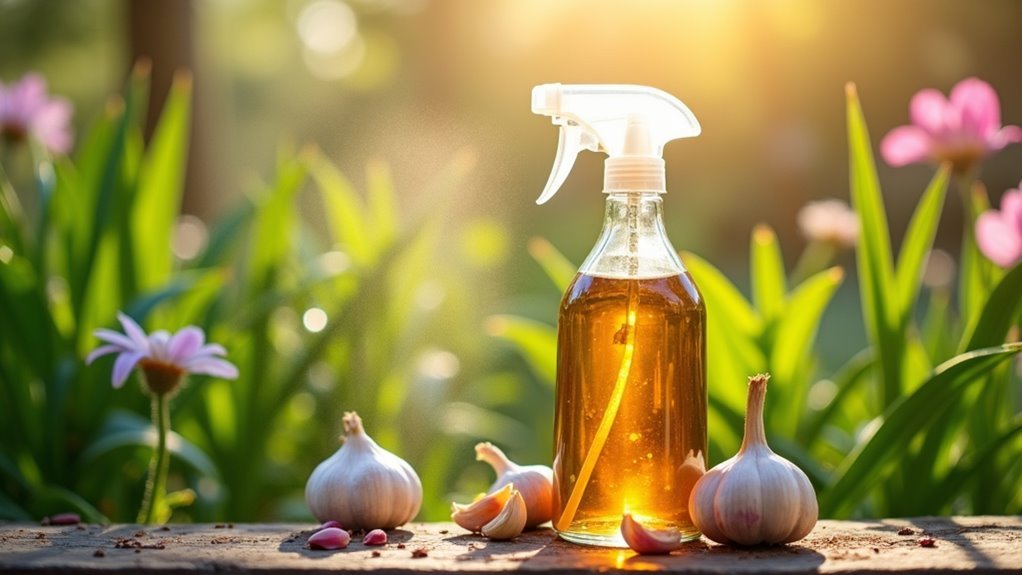You’ll transform your garden’s pest control strategy by planting calendula as a trap crop to lure aphids and whiteflies away from vulnerable plants. Position these bright flowers near roses and vegetables, then attract beneficial insects like ladybugs and lacewings with their sweet nectar. Create natural insecticidal spray by steeping dried calendula flowers in hot water, and time your planting to coincide with peak pest activity. These proven techniques will reveal calendula’s full potential for natural garden protection.
Plant Calendula as a Trap Crop to Divert Pests From Vulnerable Plants

When pests threaten your prized roses and vegetable crops, calendula can serve as your garden’s strategic defender by acting as a trap crop.
You’ll find that calendula’s bright blooms effectively lure harmful aphids, thrips, and whiteflies away from your more valuable plants. By positioning calendula strategically near vulnerable crops, you’re creating a visual magnet that diverts destructive pests to a designated area.
Calendula’s vibrant flowers act as a strategic decoy, drawing destructive aphids, thrips, and whiteflies away from your prized garden crops.
This approach allows you to concentrate your pest management efforts in specific zones rather than treating your entire garden.
You’ll notice markedly reduced infestations in nearby plants while maintaining a safe environment for beneficial insects. The concentrated pest populations on calendula make monitoring and targeted control much easier, protecting your garden’s overall health without compromising beneficial species.
Attract Beneficial Insects With Calendula’s Sweet Nectar
While calendula serves as an effective trap crop, its sweet nectar simultaneously transforms your garden into a haven for beneficial insects that’ll become your most valuable pest control allies.
Calendula attracts pollinators like butterflies and bees, while also drawing predatory insects that actively hunt garden pests. You’ll notice ladybugs, lacewings, and hoverflies congregating around these bright blooms, especially during spring and summer months.
These beneficial insects naturally manage pest populations by feeding on aphids, thrips, and other destructive garden invaders.
When you plant calendula as a companion plant, you’re creating a natural ecosystem that maintains itself. The abundant nectar keeps these helpful predators in your garden, ensuring they’re always nearby when pest problems arise, effectively reducing your need for chemical interventions.
Use Calendula Tea as a Natural Insecticidal Spray

Beyond attracting beneficial insects, calendula flowers offer another powerful pest control solution when transformed into a homemade insecticidal spray.
You can create effective calendula tea by steeping dried calendula flowers in hot water for several hours. This natural spray targets common garden pests like aphids, cabbageworms, and tobacco cutworms without harming beneficial insects.
To enhance your insecticidal spray’s effectiveness, add a few drops of dish soap to help the solution stick to plants.
A small amount of dish soap acts as a natural surfactant, improving the spray’s adherence to leaf surfaces.
Strain the calendula tea and store it in a spray bottle for easy application. Apply directly to pest-infested plants every few days until populations decrease.
Regular use of this calendula tea reduces your reliance on chemical pesticides while promoting a healthier garden ecosystem through sustainable pest control methods.
Position Calendula Near Roses and Vegetables for Protection
Strategic placement of calendula throughout your garden transforms these cheerful flowers into living shields for your most vulnerable plants.
When you plant calendula near roses and vegetables, you’re creating an effective trap crop that diverts aphids, thrips, and whiteflies away from your prized crops. This natural pest control method works exceptionally well during spring and summer when pest activity peaks.
Three key positioning strategies:
- Ring formations – Surround rose bushes with calendula borders for maximum protection.
- Vegetable garden edges – Line garden perimeters to intercept incoming pests.
- Interspersed planting – Scatter calendula between vulnerable crops for thorough coverage.
Calendula’s sweet nectar will attract beneficial insects like ladybugs and lacewings, creating a balanced ecosystem that naturally manages pest populations while boosting your garden’s overall health and aesthetic appeal.
Time Your Calendula Planting for Maximum Pest Control Benefits

Continue sowing every 2-3 weeks until early summer to maintain continuous blooms and maximize pest deterrent effects.
Time your plantings to coincide with peak activity of pests including aphids and thrips, ensuring calendula diverts them from vulnerable plants.
Strategic calendula planting during aphid and thrip peak seasons creates an effective natural trap crop to protect your vulnerable garden plants.
Avoid late summer sowing, as minimal flowering before winter reduces effectiveness.
Well-established calendula by midsummer produces vibrant blooms that attract pollinators and beneficial insects for natural pest control.
Combine Calendula With Other Companion Plants for Enhanced Defense
While calendula provides excellent pest deterrence on its own, pairing it with strategic companion plants amplifies your garden’s natural defense system.
You’ll create a powerful ecosystem that tackles multiple pest problems simultaneously.
Your calendula plants work exceptionally well when combined with specific vegetables and herbs. The bright flowers attract beneficial insects like ladybugs and lacewings, which naturally control harmful pest populations throughout your garden.
Here are three effective companion plant combinations for enhanced pest control:
- Tomatoes and peppers – Calendula acts as a trap crop, diverting aphids away from these vulnerable vegetables.
- Brassicas like cabbage and broccoli – Reduces caterpillar damage through attracted beneficial insects.
- Herbs such as basil and dill – Creates diverse pest-repelling properties while calendula attracts predatory insects.
Maintain Healthy Calendula Through Proper Watering and Care
Since your calendula’s pest-control effectiveness depends on vigorous plant health, you’ll need to master proper watering techniques and ongoing care practices.
Water calendula plants at the base rather than overhead to prevent fungal diseases like powdery mildew from developing on wet foliage. Maintain consistent soil moisture by providing at least one inch of water weekly through drip irrigation systems. Apply mulch around plants to conserve moisture, suppress weeds, and keep roots cool for peak growth.
Regular maintenance enhances healthy calendula performance. Pinch spent flowers to encourage bushier growth and extend blooming periods, which attracts more beneficial insects.
Deadheading spent calendula blooms promotes continuous flowering and denser plant growth while drawing more beneficial insects to your garden.
Monitor soil quality continuously and apply balanced fertilizer every four weeks to support vigorous development. These practices guarantee your calendula remains robust and effective at controlling garden pests.
Apply Insecticidal Soap When Beneficial Insects Are Absent
When you’re dealing with aphids, thrips, or whiteflies on your calendula plants, insecticidal soap offers an effective solution that won’t harm your garden when used correctly.
You’ll need to time your applications carefully, recognizing when beneficial insects like ladybugs and lacewings aren’t present in your garden area.
Master the proper application techniques to maximize effectiveness while protecting the helpful creatures that naturally control pest populations.
Timing Soap Applications
Although insecticidal soap effectively controls aphids and whiteflies on calendula plants, you’ll need to time your applications carefully to protect beneficial insects like ladybugs and lacewings.
Since these natural pest controllers are most active during spring and summer, strategic timing becomes essential for managing pests and diseases without disrupting your garden’s ecosystem.
Apply insecticidal soap during these ideal windows:
- Early morning or late evening when temperatures are cooler and beneficial insects are less active
- After monitoring your garden to confirm beneficial insects aren’t present on calendula plants
- When pest populations are actively feeding but natural predators have moved to other areas
Always check your plants before each application.
If you spot ladybugs or lacewings, delay treatment until they’ve relocated naturally.
Identifying Beneficial Insects
How can you distinguish between helpful garden allies and harmful pests before reaching for that insecticidal soap?
You’ll want to recognize beneficial insects that naturally control aphids and other damaging pests in your garden. Look for ladybugs with their distinctive spotted shells, lacewings with delicate transparent wings, and hoverflies that resemble small bees but actually hover near flowers.
These allies gravitate toward calendula blooms during spring and summer months, creating a natural pest management system that enhances garden health.
Before applying any treatments, take time to observe your plants carefully. If you spot these helpful insects actively working around your calendula, delay soap applications until they’ve moved on.
This simple identification step protects your garden’s natural defense system.
Soap Application Methods
Once you’ve confirmed beneficial insects aren’t actively working your calendula plants, timing becomes vital for effective soap application.
Apply insecticidal soap during early morning or late evening hours when bees and ladybugs are less active to minimize harm to these helpful creatures.
Your application methods should focus on thorough coverage of all plant parts where pests hide.
Direct contact with insects is essential for effective pest control, so don’t miss undersides of leaves or stem joints.
Follow these key steps for successful treatment:
- Test first – Apply soap solution to a small plant section to check for adverse reactions
- Avoid wet conditions – Don’t spray after rain or watering as moisture reduces effectiveness
- Repeat regularly – Reapply every 5-7 days or when new pest activity appears
Encourage Natural Predators Around Calendula Plantings
When you plant calendula in your garden, you’re creating a natural magnet for beneficial insects that’ll become your best allies in pest control.
Calendula attracts ladybugs, lacewings, and hoverflies that naturally eliminate aphids and thrips from your garden.
To maximize this natural pest control system, you’ll want to plant diverse flowering varieties alongside your calendula.
This creates enhanced habitats for predators while ensuring continuous blooms from spring through summer keeps beneficial insects active throughout the growing season.
Skip chemical pesticides entirely – they’ll destroy the helpful insects you’re trying to attract.
Instead, add shelter options like small brush piles and shallow water sources.
These additions encourage songbirds and other natural predators to visit regularly, creating an extensive biological pest management system around your calendula plantings.
Remove Garden Debris to Prevent Pest Overwintering Near Calendula
You’ll want to time your fall cleanup carefully to disrupt pest life cycles before winter sets in.
Focus on removing fallen leaves, spent flowers, and plant debris from around your calendula beds using systematic collection methods.
Proper timing and thorough removal techniques will prevent aphids, slugs, and other pests from establishing comfortable winter hideouts near your plants.
Fall Cleanup Timing
After the first frost signals the end of your growing season, you’ll want to begin removing plant debris from around your calendula beds to prevent pests from establishing winter hideouts.
Proper fall cleanup timing is essential because the first frost naturally reduces pest populations, making this the ideal moment to clear away fallen leaves and dead plant material.
Here’s your important fall cleanup checklist:
- Wait for the first hard frost to kill off active pests before starting debris removal
- Clear all fallen calendula leaves and stems that could harbor overwintering aphids and caterpillars
- Compost healthy material separately from diseased or pest-infected plant debris
This strategic timing guarantees you’re removing plant debris when pest populations are at their weakest, maximizing your garden’s health for spring.
Debris Removal Methods
Since debris removal forms the backbone of effective pest prevention, you’ll need systematic methods to clear your garden thoroughly and efficiently. Effective debris removal methods guarantee you eliminate overwintering sites for aphids and caterpillars that threaten calendula plants.
| Tool | Best Use | Frequency |
|---|---|---|
| Garden rake | Fallen leaves, light debris | Weekly during fall |
| Garden vacuum | Fine debris, hard-to-reach areas | Bi-weekly |
| Hand picking | Diseased plant material | As needed |
| Pruning shears | Dead stems, branches | Monthly |
| Wheelbarrow | Debris transport | Each cleanup session |
Always inspect garden beds after removal to identify remaining pest habitats. Compost healthy organic matter while disposing of diseased materials separately. This systematic approach prevents pathogen spread and reduces spring infestations around your calendula.
Frequently Asked Questions
What Pests Does Calendula Repel?
You’ll find calendula naturally repels aphids, thrips, and whiteflies with its strong scent. It also attracts beneficial insects like ladybugs and lacewings that’ll prey on harmful pests in your garden.
How Do I Use Calendula in My Garden?
Plant calendula near vulnerable crops like roses and vegetables as a trap crop. Deadhead flowers regularly to encourage blooms and reduce pest breeding sites. This attracts beneficial insects while drawing harmful pests away from your main plants.
What Not to Plant Next to Calendula?
Don’t plant carrots, beans, or peas near calendula since they’ll attract harmful pests or compete for nutrients. Avoid other Asteraceae plants like daisies and heavy-watering species that need different soil conditions.
Where to Plant Calendula in a Vegetable Garden?
You should plant calendula in interrows between your vegetable beds or along garden borders. Place them near tomatoes, peppers, and roses to attract beneficial insects while creating trap crops for aphids and whiteflies.
In Summary
You’ll find calendula becomes your garden’s secret weapon when you implement these natural pest control strategies. Don’t underestimate this humble flower’s power to protect your plants while supporting beneficial insects. Start with just a few calendula plants near your most vulnerable crops, and you’ll quickly see the difference. Remember, consistency in care and strategic placement will maximize your results. Your garden’s ecosystem will thank you for choosing this gentle, effective approach.





Leave a Reply